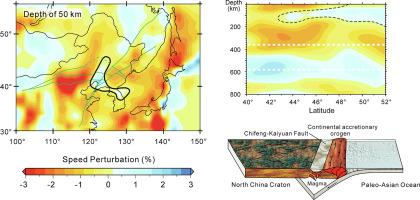Gondwana Research ( IF 7.2 ) Pub Date : 2021-08-08 , DOI: 10.1016/j.gr.2021.08.002 Jin–Peng Luan 1, 2, 3 , Jie Tang 1 , Wen–Liang Xu 1, 4 , You Tian 5 , Peng Guo 1 , Jian-Guo Wang 1 , Yu Li 6

|
The amalgamation of accretionary terranes plays an important role in the evolution of ancient accretionary orogens, but the kinematic process and its driving mechanism are commonly ambiguous. Here we provide new constraints on the accretion kinematics and associated driving mechanism of the eastern Central Asian Orogenic Belt (CAOB), using seismic tomography and magmatism. Permian to Middle Triassic magmatism was linked to two distinct accretionary orogens, that existed along the northern margin of the North China Craton. The geochemistry of middle Permian to Middle Triassic igneous rocks indicates a magmatic arc origin at an active continental margin. Based on the horizontal zoning of magmatism and south-dipping stagnant oceanic slab imaged by seismic tomography, we conclude that southward subduction of the oceanic slab resulted in the accretion and collision of multiple arc systems along the continental margin. Our seismic tomographic models indicate that formation and growth of the eastern CAOB occurred as the result of the continuous accretion and amalgamation of arc assemblages with addition of crustal material. Tomographic models and previous Re-Os geochronological studies indicate the existence of a deep crustal root and ancient sub-continental lithospheric mantle in most regions of the eastern CAOB. Taking into account the magmatic evolution and sedimentary sequences, we conclude that the terrane accretion should be the driving mechanism of accretionary orogenesis in the eastern CAOB.
中文翻译:

中亚造山带东部增生运动学及驱动机制——吉林中部地震层析成像与中二叠世-中三叠世岩浆作用的洞察
增生地体的并合作用在古增生造山带的演化过程中具有重要作用,但其运动过程及其驱动机制普遍不明确。在这里,我们使用地震层析成像和岩浆作用对中亚造山带东部 (CAOB) 的吸积运动学和相关驱动机制提供了新的约束。二叠纪至中三叠世岩浆活动与存在于华北克拉通北缘的两个不同的增生造山带有关。中二叠世至中三叠世火成岩的地球化学表明岩浆弧起源于活动大陆边缘。基于地震层析成像的岩浆活动水平区带和南倾停滞大洋板块,我们得出结论,大洋板块向南俯冲导致了沿大陆边缘的多个弧系统的增生和碰撞。我们的地震层析成像模型表明,CAOB 东部的形成和生长是随着地壳物质的加入,弧组合不断增生和合并的结果。层析模型和先前的 Re-Os 年代学研究表明,在中亚盆地东部大部分地区存在深地壳根部和古老的次大陆岩石圈地幔。考虑到岩浆演化和沉积序列,我们认为地体增生应该是中亚盆地东部增生造山作用的驱动机制。我们的地震层析成像模型表明,CAOB 东部的形成和生长是随着地壳物质的加入,弧组合不断增生和合并的结果。层析模型和先前的 Re-Os 年代学研究表明,在中亚盆地东部大部分地区存在深地壳根部和古老的次大陆岩石圈地幔。考虑到岩浆演化和沉积序列,我们认为地体增生应该是中亚盆地东部增生造山作用的驱动机制。我们的地震层析成像模型表明,CAOB 东部的形成和生长是随着地壳物质的加入,弧组合不断增生和合并的结果。层析模型和先前的 Re-Os 年代学研究表明,在中亚盆地东部大部分地区存在深地壳根部和古老的次大陆岩石圈地幔。考虑到岩浆演化和沉积序列,我们认为地体增生应该是中亚盆地东部增生造山作用的驱动机制。层析模型和先前的 Re-Os 年代学研究表明,在中亚盆地东部大部分地区存在深地壳根部和古老的次大陆岩石圈地幔。考虑到岩浆演化和沉积序列,我们认为地体增生应该是中亚盆地东部增生造山作用的驱动机制。层析模型和先前的 Re-Os 年代学研究表明,在中亚盆地东部大部分地区存在深地壳根部和古老的次大陆岩石圈地幔。考虑到岩浆演化和沉积序列,我们认为地体增生应该是中亚盆地东部增生造山作用的驱动机制。










































 京公网安备 11010802027423号
京公网安备 11010802027423号